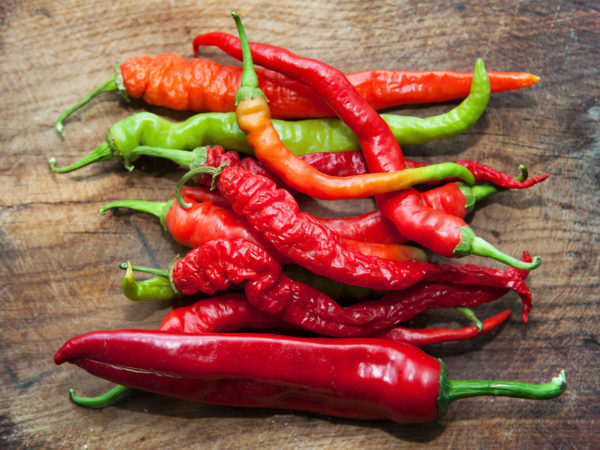Which Peppers Are Hot?
I am trying new recipes that contain spices, herbs and peppers I have never used. How do I tell which peppers are mild or hot? I would also like to know if the heat factor diminishes when peppers are cooked?
Andrew Weil, M.D. | November 24, 2016

I’m glad to hear you’re experimenting with spices, herbs and peppers, all of which are good sources of protective phytonutrients. Here in the American Southwest, chili peppers – the hot ones – are staples. At the True Food Kitchen restaurants we incorporate chili peppers into both savory and sweet dishes. They’re a great addition to hot chocolate, for example.
You’re probably most familiar with bell peppers, which aren’t at all hot. They can be green, red, yellow, orange, white, pink and even purple and have a sweet, mild flavor. They can be harvested when they’re green but will turn bright red, yellow, or orange and become sweeter and more nutritious as they mature. Look for bell peppers with firm, tight skin, avoiding those that look dull or shriveled. Nutritionally, these peppers provide an amount of vitamin C that’s almost twice the recommended daily intake, as well as vitamin A, folate and vitamin E. Red bell peppers also provide lycopene, an important carotenoid that may help protect against prostate cancer and other cancers.
There are many types of hot peppers, which owe their heat to varying amounts of capsaicin, a compound that stimulates metabolism and circulation, helps lower blood pressure, inhibits pain perception and may reduce inflammation. The highest concentrations of capsaicin are in the pepper’s placenta – the white tissue to which seeds are attached. You can tame chilies by removing this before using them. (Contrary to popular belief, the seeds contain no capsaicin at all.) The hotness of chili peppers is ranked on the Scoville Index, which relies on subjective reports of a panel of tasters. Generally, the Scoville score correlates with capsaicin content. A sweet bell pepper has a Scoville rating of zero, while the Naga-Bih Jolokia, the hottest pepper listed, scores 1,001,304 heat units, making it nearly twice as hot as the runner-up, the Red Savino Habañero. (The index also ranks hot sauces.) Here’s a rundown of the most common hot peppers:
- Jalapeños: With a ranking of 2,500 to 5,000 Scoville units, the jalapeño can be red or green and usually is 2 to 3 inches long. Jalapeños are widely used in spicy Mexican food. (Chipotles are red, ripe jalapeños that have been dried and smoked.)
- Serranos: These Mexican peppers are smaller than jalapeños and much hotter, with between 10,000 and 25,000 Scoville units. Green serranos are more common, but you can sometimes find red ones also. Use them in salsas and sauces.
- Habañeros: These are really hot peppers, with between 80,000 and 600,000 Scoville units. Habañeros usually are orange but can also be red, brown and white. They are believed to have originated in Mexico’s Yucatan Peninsula. You can find recipes containing habañero peppers online.
Cooking does not reduce the heat of chili peppers. Be sure to treat hot peppers with care – don’t touch your eyes if you have handled them, and use rubber gloves to avoid irritating your hands when cutting them.
Andrew Weil, M.D.
Source:
Fatima Cardoso et al, “70-Gene Signature as an Aid to Treatment Decisions in Early-Stage Breast Cancer.” New England Journal of Medicine, August 25, 2016, DOI: 10.1056/NEJMoa1602253










